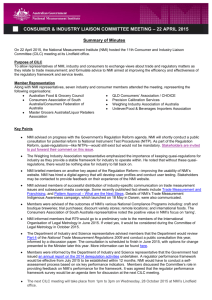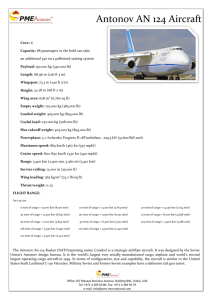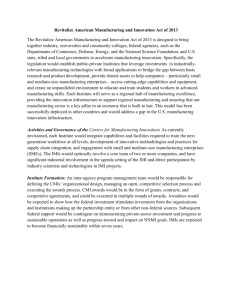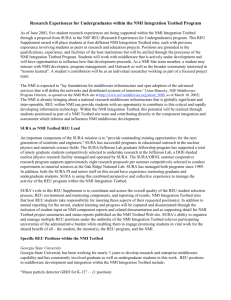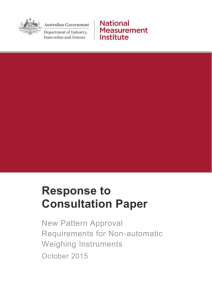20021029-Middleware-West
advertisement
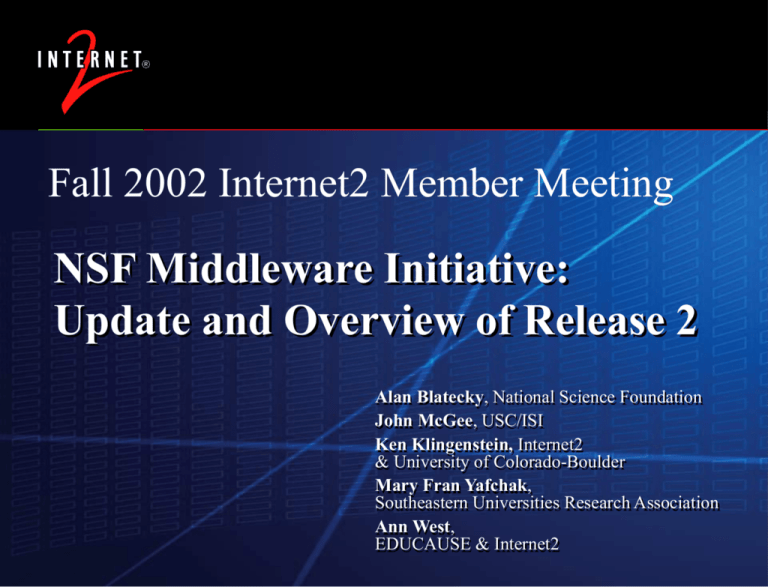
Fall 2002 Internet2 Member Meeting NSF Middleware Initiative: Update and Overview of Release 2 18 March 2016 Alan Blatecky, National Science Foundation John McGee, USC/ISI Ken Klingenstein, Internet2 & University of Colorado-Boulder Mary Fran Yafchak, Southeastern Universities Research Association Ann West, EDUCAUSE & Internet2 Session Topics NSF Middleware Initiative Overview GRIDS Center NMI-EDIT NMI Integration Testbed NMI Outreach and Participation 2 NSF Middleware Initiative Purpose To design, develop, deploy and support a set of reusable, expandable set of middleware functions and services that benefit applications in a networked environment 3 NMI Organization Core NMI Team • GRIDS Center – ISI, NCSA, U Chicago, UCSD & U Wisconsin • EDIT Team (Enterprise and Desktop Integration Technologies) – EDUCAUSE, Internet2 & SURA Grants for R & D • Year 1 -- 9 grants • Year 2 -- 9 grants 4 A Vision for Middleware To allow scientists and engineers the ability to transparently use and share distributed resources, such as computers, data, and instruments To develop effective collaboration and communications tools such as Grid technologies, desktop video, and other advanced services to expedite research and education, and To develop a working architecture and approach which can be extended to Internet users around the world. Middleware is the stuff that makes “transparently use” happen, providing persistency, consistency, security, privacy and capability 5 NMI Goals a) facilitate scientific productivity, b) increase research collaboration through shared data, computing, code, facilities and applications, c) support the education enterprise, d) encourage the participation of industry, government labs and agencies for more extensive development and wider adoption and deployment, e) establish a level of persistence and availability so that other applications developers and disciplines can take advantage of the middleware, f) encourage and support the development of standards and open source approaches and, g) enable scaling and sustainability to support the larger research and education communities. 6 NMI Process Experimental Software & research applications Early Implementations - GRID services, directories, authentication, etc Research & Education Early Adopters Consensus - disciplines - communities - industries MiddlewareTestbeds - experimental, Beta, scaling & “hardening” Dissemination & Support Middleware deployment 7 First Deliverables: NMI Release 1 Software • (Globus, Condor, Network Weather Service, KX.509, CPM, Pubcookie) Object Classes • (eduPerson, eduOrg, commObject) White Papers (Shibboleth, video directories, etc) Best Practices (Directories, LDAP) Policies (campus certificates, account management) Services (certificate profile registry) www.nsf-middleware.org 8 NMI Release 2 Release 2 shipped on Oct-25-2002 New versions • Globus Toolkit, Condor-G, Network Weather Service, Pubcookie, etc New components and best practices • OpenSAML 1.0, Shibboleth 1.0, etc • GSI-OpenSSH, Gridconfig Tools • LDAP Analyzer, Metadirectory Practices for Enterprise Directories, etc Two releases each year: April/October Release being adopted by projects, agencies International interest in releases 9 3rd Year Program of NMI Program Announcement in process March 3, 2003 Proposal deadline $7M available for FY’03 http://www.nsf-middleware.org 10 GRIDS Center Overview John McGee USC, Information Sciences Institute mcgee@isi.edu 11 GRIDS Center, Part of the NSF Middleware Initiative One of two NMI teams, the GRIDS Center (Grid Research, Integration, Development & Support) In late 2001, GRIDS created to: • Define, develop, deploy, and support an integrated national middleware infrastructure for 21st Century S&E • Create robust, tested, packaged, & documented middleware for S&E, including large NSF projects (e.g., NEES, GriPhyN, TeraGrid) • Work with middleware research community to evolve architecture & integrate other components • Provide dedicated operations capability for 24x7 support and monitoring of Grid infrastructure 12 GRIDS Center Participants The Information Sciences Institute (ISI), University of Southern California (Carl Kesselman) The University of Chicago (Ian Foster) The National Center for Supercomputing Applications (NCSA) at the University of Illinois at Urbana-Champaign (Randy Butler) The San Diego Supercomputer Center (SDSC) at the University of California at San Diego (Phil Papadoupolus) The University of Wisconsin at Madison (Miron Livny) 13 Elements of Grid Computing Resource sharing as a fundamental pursuit • Computers, storage, sensors, networks • Sharing is always conditional, based on issues of security, trust, policy, negotiation, payment, etc. Coordinated problem solving • Beyond client-server: distributed data analysis, computation, collaboration, etc. Dynamic, multi-institutional “virtual organizations” • Community overlays on classic org structures • Large or small, static or dynamic 14 Grid-Oriented Projects in eScience 15 Grid Applications Science portals • Help scientists overcome steep learning curves of installing and using new software Distributed computing • High-speed workstations and networks as aggregated computational resources Large-scale data analysis Computer-in-the-loop instrumentation • Grids permit quasi-real-time analysis of data from telescopes, synchrotrons, and electron microscopes Collaborative work • Grids enable collaborative problem formulation, data analysis, and discussion 16 Grid Portals 17 Mathematicians Solve NUG30 Looking for the solution to the NUG30 quadratic assignment problem An informal collaboration of mathematicians and computer scientists Condor-G delivered 3.46E8 CPU seconds in 7 days (peak 1009 14,5,28,24,1,3,16,15, processors) in U.S. and Italy (8 10,9,21,2,4,29,25,22, sites) 13,26,17,30,6,20,19, 8,18,7,27,12,11,23 MetaNEOS: Argonne, Iowa, Northwestern, Wisconsin 18 Home Computers Evaluate AIDS Drugs Community = • 1000s of home computer users • Philanthropic computing vendor (Entropia) • Research group (Scripps) Common goal = advance AIDS research 19 Sloan Digital Sky Survey Analysis Size distribution of galaxy clusters? Galaxy cluster size distribution 100000 Chimera Virtual Data System + iVDGL Data Grid (many CPUs) 10000 1000 100 10 20 1 1 10 Number of Galaxies 100 iVDGL: International Virtual Data Grid Laboratory Tier0/1 facility Tier2 facility Tier3 facility 10 Gbps link 2.5 Gbps link 622 Mbps link 21 Other link Network for Earthquake Engineering Simulation NEESgrid: US national infrastructure to couple earthquake engineers with experimental facilities, databases, computers, and each other On-demand access to experiments, data streams, computing, archives, collaboration NEESgrid is a partnership of Argonne, Michigan, NCSA, UIUC, USC 22 The 13.6 TF TeraGrid: Computing at 40 Gb/s 26 Site Resources HPSS 4 Site Resources HPSS 24 8 External Networks Caltech HPSS 5 Argonne External Networks External Networks Site Resources External Networks SDSC 4.1 TF 225 TB NCSA/PACI 8 TF 240 TB TeraGrid: NCSA, SDSC, Caltech, Argonne Site Resources UniTree www.teragrid.org 23 Grids and Industry Grid computing has much in common with major industrial thrusts to decentralize (e.g., B2B, P2P, ASP, etc.) Sharing issues are not adequately addressed by existing technologies Companies like IBM, Platform Computing and Microsoft are now substantively involved with the open-source Grid community (e.g., OGSA, which combines Web services and Grid services) 24 GRIDS Software for NMI GRIDS Center Software Suite in the first release (NMI-R2) is a package of: • • • • • • • • Globus Toolkit™ Condor-G Network Weather Service KX.509 & KCA GSI-OpenSSH Gridconfig Tools Grid Packaging Tools For RedHat 7.2/7.3 on IA32, Solaris 8 on 32-bit Sparc 25 Enterprise and Desktop Integration Technologies (EDIT) Consortium Ken Klingenstein Director, Internet2 Middleware Initiative kjk@internet2.edu 26 NMI-EDIT Consortium Enterprise and Desktop Integration Technologies Consortium • Internet2 – primary on grant and research • EDUCAUSE – primary on outreach • Southeastern Universities Research Association (SURA) – primary on NMI Integration Testbed Grant funding is ~$1.2 million a year: • about ½ to short-term partial hiring of campus IT staff to develop and document required standards, best practices, etc. • about ½ to testbeds, dissemination and training sessions Almost all funding passed through to campuses for work 27 NMI-EDIT: Goals Much as at the network layer, create a ubiquitous common, persistent and robust core middleware infrastructure for the R&E community In support of inter-institutional and inter-realm collaborations, provide tools and services (e.g. registries, bridge PKI components, root directories) as required 28 NMI-EDIT: Objectives • Foster the development of campus enterprise middleware to leverage both the academic and administrative missions. • Coordinate a common substrate across higher ed middleware implementations that would permit interinstitutional efforts such as Grids, digital libraries, and collaboratories to scale and leverage • In some instances, build collaboration tools for particularly important inter-institutional and government interactions, such as web services, PKI and video. • Insure that distinctive higher-ed requirements, from privacy and academic freedom to multi-realm portals, are served in the marketplace. 29 A Map of Middleware Land 30 NMI-EDIT: Core Middleware Scope Identity and Identifiers – namespaces, identifier crosswalks, real world levels of assurance Authentication – campus technologies and policies, inter-realm interoperability via PKI, Kerberos Directories – enterprise directory services architectures and tools, standard object classes, interrealm and registry services Authorization – permissions and access controls, delegation, privacy management Integration Activities – common management tools, use of virtual, federated and hierarchical organizations 31 NMI-EDIT: Organization Overall technical direction set by MACE • Middleware Architecture Committee for Education (MACE) • Bob Morgan, University of Washington, Chair • Campus IT architects and representatives from Grids and International Communities Directions set via • NSF and NMI management team • Internet2 Network Planning and Policy Advisory Council • PKI and Directory Technical Advisory Boards • Internet2 members 32 Sample NMI-EDIT Process (Directories ) MACE-DIR Working Group prioritizes needed materials Subgroups established: • • • revision of basic documents (LDAP Recipe) new best practices in groups and metadirectories standards development for eduPerson 1.5 and eduOrg 1.0 Subgroups work in enhanced IETF approach: scenarios, requirements, architectures, recommended standards stages Working group deliverables announced; input and conference call review/feedback processes start; work groups reconvene as needed Process takes around 4-6 months, depending on product 6-8 people drive the process with 15-50 schools participating 33 NMI-EDIT: Participants Higher Ed – 15-20 leadership institutions, with 50 more campuses represented as members of working groups; readership around 2000 institutions Corporate - (IBM/Metamerge, Microsoft, SUN, Liberty Alliance, DST, MitreTek, Radvision, Polycom, EBSCO, Elsevier, OCLC, Baltimore) Government – NSF, NIST, NIH, Federal CIO Council International – Terena, JISC, REDIRIS, AARnet, SWITCH 34 A Few Year-One NMI-EDIT Milestones Sept 1, 2001 – Grant awarded Oct 2001– eduPerson 1.0 finalized; outreach begins with multiple workshops Jan 2002 – HEBCA tested; first CAMP workshop held Feb 2002 – PKI Lite CP/CPS; e-Gov and Management and Leadership Best Practice Awards April 2002 – Shibboleth alpha ships; NMI testbed selected; NIST/NIH PKI workshop May 2002 – NMI release, with eduPerson 1.5, pubcookie, KX.509, groups and metadirectories, video white papers June 2002 – affiliated directories begins; Base CAMP; testbed kickoff July 2002 – Shibboleth alpha v 2 ships; Advanced CAMP August 2002 – LDAP Analyzer testing begins; Shibboleth pilot-sites selected; Work with content providers begins September 2002 – Grant renewed; supplemental grant awarded for outreach; Shibboleth beta ships 35 NMI-EDIT: Release 1 Deliverables Software KX.509 and KCA, Certificate Profile Maker, Pubcookie Object Classes eduPerson 1.0, eduPerson 1.5, eduOrg 1.0, commObject 1.0 Service Certificate Profile Registry 36 NMI-EDIT: Release 1 Deliverables Conventions and Practices • Practices in Directory Groups 1.0, LDAP Recipe 2.0 • Metadirectory Practices for the Enterprise Directory in Higher Education 1.0 White Papers • Shibboleth Architecture v5 Policies • Campus Certificate Policy for use at the Higher Education Bridge Certificate Authority (HEBCA) • Lightweight Campus Certificate Policy and Practice Statement (PKI-Lite) • Sample Campus Account Management Policy 37 NMI-EDIT: Release 1 Deliverables Works in Progress •Role of Directories in Video-on-Demand •Resource Discovery for Videoconferencing •Directory Services Architecture for Video and Voice Conferencing over IP (commObject) 38 NMI-EDIT: Release 2 New/Revised Deliverables Software Programs and Libraries –OpenSAML 1.0 –Shibboleth 1.0 –Pubcookie 3.0 Directory Schemas –eduPerson –eduOrg 39 NMI-EDIT: Release 2 New/Revised Deliverables Conventions and Practices •LDAP Recipe •Metadirectory Practices for Enterprise Directories •Practices in Directory Groups Architectures •Inter-domain Data Exchange (Draft) Services • LDAP Analyzer 40 The pieces fit together… Campus infrastructure • Name space, identifiers, directories • Enterprise authentication and authorization Inter-realm infrastructure • edu object classes • Exchange of attributes Inter-realm Upperware • Grids • Digital libraries • Video 41 NMI Integration Testbed Mary Fran Yafchak Testbed Manager, Southeastern Universities Research Association maryfran@sura.org 42 NMI Integration Testbed Focus on the integration of released middleware components with real life use and conditions Elements: Sites, Manager, Workshop Integration is the point - could think of it as… • Where “EDIT” meets “GRIDS” • Where enterprise needs meet research needs • Where NMI components meet reality 43 NMI Integration Testbed Planning and management by SURA Participating Sites: • University of Alabama at Birmingham • University of Alabama in Huntsville • University of Florida • Florida State University • Georgia State University • Texas Advanced Computing Center (U Texas/Austin) • University of Virginia • University of Michigan 44 NMI Integration Testbed NMI Participation USERS Implementers Target Communities NMI Integration Testbed CONTRIBUTORS DEVELOPERS SUPPORTERS NMI Integration Testbed Core Testbed Sites UAB UAH UFL FSU GSU UMich TACC UVA future expansion ? 45 NMI Integration Testbed Recent Activities Testbed Kickoff June 10 - 12, 2002 at GSU Site Integration Plans completed in July 2002 Testing of Release 1 completed Press release & Web site announced 9/4/02 • See http://www.nsf-middleware.org/testbed Open Testbed BoF here at I2 Members’ Meeting • Wednesday, October 30, 11:45AM-1:15PM 46 NMI Integration Testbed Some Highlights from the Sites • Twenty-six very real institutional projects and applications “on board” for NMI integration - with more to come... • Ten projects targeting increased access to their existing or planning scientific grids (including emerging TeraGrid) through NMI Globus • Five sites actively implementing enterprise scale directories, with centralized authentication and integrated applications • Active PKI efforts, from PKI Lite to PKI “heavy” (maintaining HIPPA/FERPA compliance) • New collaborative tools also represented, such as click-todial desktop video conferencing and shared calendaring 47 NMI Integration Testbed From R1 to R2 • Summarizing evaluation results from R1 - to be made available on the Testbed Web site • Working with Outreach to disseminate lessons learned thus far • R2-specific Component Testing Guidelines under development • Testbed Sites actively refreshing site plans and project sets with respect to R2 • R2 evaluation soon to be underway... 48 NMI Integration Testbed Potential for Expansion Already on our minds... • Increase opportunities for both sponsored and unsponsored participation • Define a role and means of involvement for international participants • Define a role and means of involvement for corporate participants • Develop “hot topic” or application-specific testbeds – E.g., Digital Libraries, Digital Video, Medical middleware, Discipline-specific grids 49 NMI Outreach and Participation NMI Participation and Outreach Ann West NMI-EDIT Outreach, EDUCAUSE/Internet2/Michigan Tech awest@educause.edu 50 NMI Outreach and Participation Targeted Communities Outreach Strategy Results from PHASE I – Building Awareness Activities and Plans for PHASE II – Delivering on Promise 51 NMI Outreach – Targeted Communities TERTIARY CIRCLE - General Interest (Targeted NEW User Communities – Press/PR) SECONDARY CIRCLE Participating/User Communities (NEES, GriPhyN, TeraGrid, Campuses, etc.) PRIMARY CIRCLE NMI Project Team GRIDS Center NMIEDIT Corporat e Partners (vendors, other industry) NMI Advisory Council 52 NMI Outreach Strategy Sep 2001 Phase I Building Awareness (Months 19) We are HERE in time Creating effective intellectual capital building blocks for the general program Broad information dissemination Aggressive outreach/marketing to higher-ed, industry, research communities Phase II Delivering on promise (Months 6-20) Interactive communication with primary user communities Building and disseminating “success stories” Development of detailed documentation, targeted events/activities and specific intellectual capital Phase III Extending the reach (Months 12-24) Refining engagement strategy – independent and sustainable Implementing “reference library” – evidence of program credibility. Establish regular schedule of events/activities 53 Phase I – Building Awareness GOAL: Creating effective intellectual capital building blocks regarding the general program – • Websites – www.nsf-middleware.org – www.grids-center.org – www.nmi-edit.org • Logo(s) created • Initial NSF Award Announcement Press Release issued (24 September 2001) • Three Campus Architecture and Middleware Planning workshops 54 Phase I – Building Awareness GOAL: Broad information dissemination – • E-lists created encouraging “virtual” involvement: – nmi-developer - Discuss NMI releases and development activities with the open source community. – nmi-supporter - Find out about Initiative-supporting opportunities and how you can incorporate components from and NMI release into your products. – nmi-user - Find out about new project and participation opportunities with the NMI. – news - Receive NMI and Initiative-related press information – nmi-announce - Keep informed about new developments in the NMI. • Internet2 – mw-discuss – Discuss topics in enterprise middleware. – mw-announce – Receive information on upcoming educational and participation opportunities 55 Phase I – Building Awareness GOAL: Aggressive outreach/marketing to higher-ed, industry and the research community • Selected speaking opportunities – Internet2, EDUCAUSE, Coalition for Networked Information, GGF-3 and GGF-4, SC2001 • Defined and implemented a strategy for involving selected vendor/industry partners – NMI Participation Model 56 NMI Participation USERS CONTRIBUTORS DEVELOPERS Targeted User Communities Other Interested implementers - Develop NMI-related or derived components - Support NMI components - campuses - GriPhyN, NEES, etc - campuses - industry - government NMI Testbed Participants SUPPORTERS - Repackage NMI components and distribute under own label - determined by Call for Participation 57 Phase II – Delivering on the Promise GOAL: Interactive communication with primary user communities – • NMI Documentation Team formed – working on plans for appropriate Technical and other documentation to support NMI Releases • Coordinated with Training and Support Team to ensure consistency and accuracy of messages to the users. 58 Phase II – Delivering on the Promise GOAL: Building and disseminating “success stories” and other achievements – • NMI Release 1 successfully delivered (7 May 2002) • Announcements of NMI R1 distributed via information distribution channels established – press lists, e-lists, website. • NMI Testbed Participants engaged in Outreach to share their stores – Internet2 tutorials and upcoming EDUCAUSE regional meetings – NMI SC2002 theme – “Sharing NMI User Experiences” (related activities and documentation) 59 Phase II – Delivering on the Promise Development of detailed documentation, targeted events/activities, and specific, in-depth intellectual capital • Articles – “Middleware: The New Frontier” – EDUCAUSE Review, July/August 2002 – “Middleware: Addressing the Top IT Issues on Campus” – EDUCAUSE Quarterly, Vol. 25, No. 4 2002 • Presentations planned – GGF5, I2 Fall Meeting, SC2002, EDUCAUSE Regionals, Coalition for Networked Information, and others • Tutorials/workshops planned – GRIDS Center, EDIT – SC2002, EDUCAUSE, Internet2 meetings, and others • Schedule for Year 2 deliverables in progress – Base CAMP February 5-7, 2003 - Tempe, Arizona 60 Interested in NMI? Visit the NMI web – http://www.nsf-middleware.org Subscribe to NMI discussion and awareness e-lists Potential User? • Visit the NMI Release site and “test drive” NMI packaged releases. Potential Contributor? • Send email to nmi-supporter@nsf-middleware.org indicating interest in contributing components to the next release. Press? • Contact outreach@nsf-middleware.org about newsworthy activities and achievements. 61 Questions? Alan Blatecky – ablatecky@nsf.gov Ken Klingenstein – kjk@internet2.edu John McGee – mcgee@isi.edu Mary Fran Yafchak – maryfran@sura.org Ann West – awest@educause.edu 62 www.internet2.edu 63


